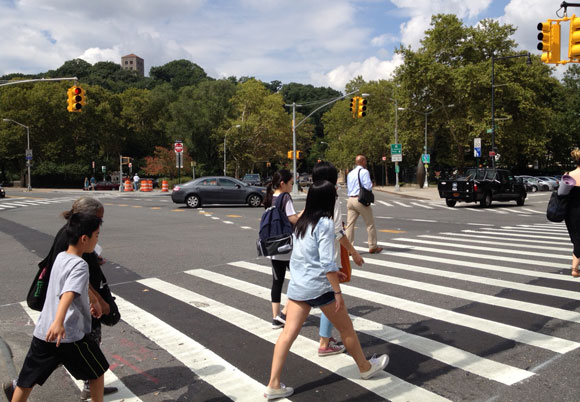
Split-phase traffic signals protect pedestrians and cyclists by separating them from turning drivers -- people walking and biking across the street get their own signal phase, and drivers turning into the crosswalk get another. Research indicates that split-phase signals are highly effective at preventing traffic injuries and deaths. But when DOT revealed its strategy to reduce crashes caused by left-turning drivers, there was no commitment to increase the use of split-phase signals.
DOT is scaling up a similar intervention -- leading pedestrian intervals, which allow pedestrians to enter intersections a few seconds before turning drivers get a green light. LPIs reduce injuries too, but not as much as split-phase signals, according to a 2014 DOT-funded study published in the journal "Accident Analysis and Prevention" [PDF].
The study analyzed crash data from 68 New York City intersections with either LPIs or split phases between 2000 and 2007, though the vast majority -- 59 -- had LPIs. Both types of signal adjustments performed better than a control group of intersections where turning drivers were permitted to proceed at the same time as pedestrians and cyclists. The improvement was more pronounced, however, at split-phase signals.
At intersections equipped with split-phase signals, pedestrian and cyclist injuries declined a precipitous 67 percent. At intersections with LPIs, pedestrian injuries declined 38 percent and bicyclist injuries 52 percent. (For the control group, the reduction was 25 percent for pedestrians and 44 percent for cyclists.) The data on split-phase signals was limited, however -- it came from only nine intersections, with no locations in Manhattan.
Left-turning drivers cause 19 percent of serious pedestrian and bicyclist injuries in NYC, three times the rate caused by drivers turning right, according to DOT's recent "Don't Cut Corners" report [PDF]. To reduce left-turn collisions, DOT installed 417 LPIs last year, a major increase, and plans to add another 500 in 2016. DOT is also piloting the use of "split LPIs" that give turning drivers a blinking yellow light after the pedestrian head start, as well as design treatments like "enhanced daylighting" to get drivers to take turns more carefully.
In the Don't Cut Corners report, DOT cites data from 104 intersections with LPIs, where fatal and serious injury crashes fell 56 percent. That is a very significant improvement. But if split-phase signals do an even better job, as the “Accident Analysis and Prevention” study indicates, why isn't DOT installing more of them?
DOT Director of Strategic Initiatives Juan Martinez said the 2014 study relied on too small a sample and limited "after" data (two years worth) to draw firm conclusions about split-phase signals compared to LPIs. "They just didn’t have a lot of intersections to work with,” he said.
Martinez pointed to the 56 percent reduction in serious crashes as evidence of the efficacy of LPIs, arguing that split-phase signals are conducive to high-speed turns, which are more likely to result in severe injury and death if a collision occurs. “What it comes down to is speed," he said. "How can we slow down the driver?”
The condition where DOT looks to add split-phase signals, he added, is where "you have a very heavy turn volume and a heavy pedestrian volume, and we don’t think we can either slow the turns or that we can protect pedestrians otherwise.”
Christine Berthet, who has prodded DOT to install more split-phase signals through her work at the Clinton-Hell's Kitchen Coalition for Pedestrian Safety and Manhattan Community Board 4, said DOT is often reluctant to install them even in the conditions that Martinez described.
At 41st Street and Ninth Avenue, she said, DOT resisted CB 4's call for a split-phase signal until a truck driver struck and killed pedestrian Shu Ying Liu at the intersection in 2013. More recently, advocates have requested a split-phase crossing at 57th and Eighth, another intersection with lots of pedestrians, but Berthet said DOT cited the heavy turn volume as a reason not to implement one.
Berthet questions why DOT didn't publish data on the safety effect of split-phases in its Don't Cut Corners report.
Martinez said DOT is working with a data analysis firm for a more comprehensive study on the effectiveness of different types of intersection treatments. There is no timetable for that study's completion.





